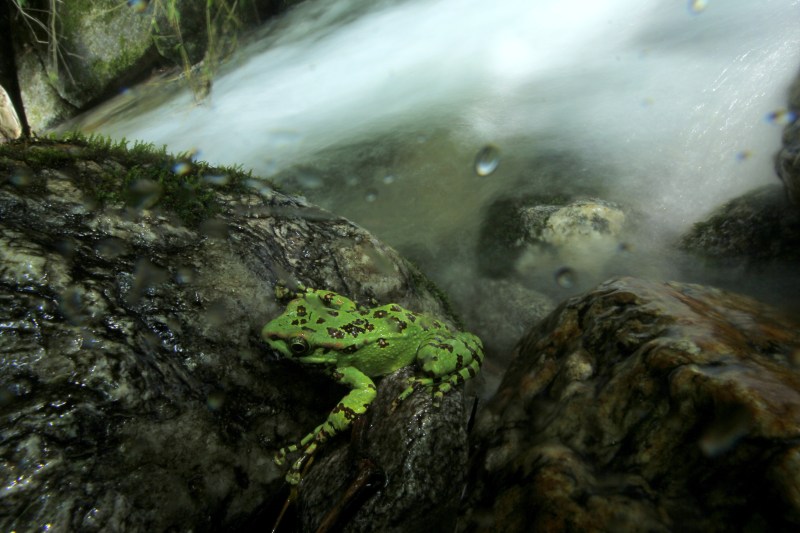
An international collaborative research group of members from seven institutions has developed a method to determine which amphibians (frogs, newts and salamanders) inhabit a specific area. Their work was published in the open-access, peer-reviewed journal Metabarcoding and Metagenomics (MBMG).
To do so, the scientists amplified and analysed extra-organismal DNA (also known as environmental DNA or eDNA) found in the water. This DNA ends up in the water after being expelled from the amphibian’s body along with mucus and excrement.
The research group included Postdoctoral Researcher Sakata K. Masayuki and Professor Minamoto Toshifumi (Kobe University), Associate Professor Kurabayashi Atsushi (Nagahama Institute of Bio-Science and Technology), Nakamura Masatoshi (IDEA Consultants, Inc.) and Associate Professor Nishikawa Kanto (Kyoto University).
The newly developed technique will resolve some of the issues with conventional methods, such as capture and observational surveys, which require a specialist surveyor who can visually identify species. Conventional surveys are also prone to discrepancies due to environmental factors, such as climate and season.
The researchers hope that the new method will revolutionise species monitoring, as it will enable anyone to easily monitor the amphibians that inhabit an area by collecting water samples.
While monitoring in general is crucial to conserve the natural ecosystems, the importance of surveying amphibians is even more pressing, given the pace of their populations’ decline.
Amongst major obstacles to amphibian monitoring, however, are the facts that they are nocturnal; their young (e.g. tadpoles) and adults live in different habitats; and that specialist knowledge is required to capture individuals and identify their species. These issues make it particularly difficult to accurately survey amphibians in a standardised way, and results of individual efforts often contradict each other.
On the other hand, eDNA analysis techniques have already been established in programmes targeted at monitoring fish species, where they are already commonplace. So, the researchers behind the present study joined forces to contribute towards the development of a similar standardised analysis method for amphibians.
First of all, the researchers designed multiple methods for analysing the eDNA of amphibians and evaluated their performance to identify the most effective method. Next, they conducted parallel monitoring of 122 sites in 10 farmlands across Japan using the developed eDNA analysis along with the conventional methods (i.e. capture surveys using a net and observation surveys).
As a result, the newly developed method was able to detect all three orders of amphibians: Caudata (the newts and salamanders), Anura (the frogs), and Gymnophiona (the caecilians).
Furthermore, this novel eDNA analysis method was able to detect more species across all field study sites than the conventional method-based surveys, indicating its effectiveness.
Research Background
Amphibian biodiversity is continuing to decline worldwide and collecting basic information about their habitats and other aspects via monitoring is vital for conservation efforts. Traditional methods of monitoring amphibians include visual and auditory observations, and capture surveys.
However, amphibians tend to be small in size and many are nocturnal. The success of surveys varies greatly depending on the climate and season, and specialist knowledge is required to identify species. Consequently, it is difficult to monitor a wide area and assess habitats. The last decade has seen the significant development of environmental DNA analysis techniques, which can be used to investigate the distribution of a species by analysing external DNA (environmental DNA) that is released into the environment along with an organism’s excrement, mucus and other bodily fluids.
The fundamentals of this technique involve collecting water from the survey site and analysing the eDNA contained in it to find out which species inhabit the area. In recent years, the technique has gained attention as a supplement for conventional monitoring methods. Standardised methods of analysis have already been established for other species, especially fishes, and diversity monitoring using eDNA is becoming commonplace.
However, eDNA monitoring of amphibians is still at the development stage. One reason for this is that the proposed eDNA analysis method must be suitable for the target species or taxonomic group, and there are still issues with developing and implementing a comprehensive method for detecting amphibians. If such a method could be developed, this would make it possible for monitoring to be conducted even by people who do not have the specialised knowledge to identify species nor surveying experience.
Hopefully, this would be established as a unified standard for large-scale monitoring surveys, such as those on a national scale. This research group’s efforts to develop and evaluate analysis methods will hopefully lay the foundations for eDNA analysis to become a common tool for monitoring amphibians, as well as fish.
***
Follow Metabarcoding and Metagenomics (MBMG) journal on Twitter and Facebook.
***
Research article:
Sakata MK, Kawata MU, Kurabayashi A, Kurita T, Nakamura M, Shirako T, Kakehashi R, Nishikawa K, Hossman MY, Nishijima T, Kabamoto J, Miya M, Minamoto T (2022) Development and evaluation of PCR primers for environmental DNA (eDNA) metabarcoding of Amphibia. Metabarcoding and Metagenomics 6: e76534. https://doi.org/10.3897/mbmg.6.76534




























